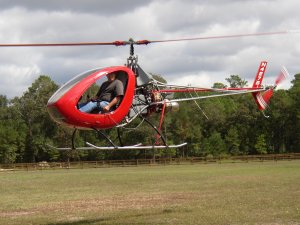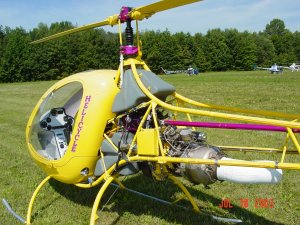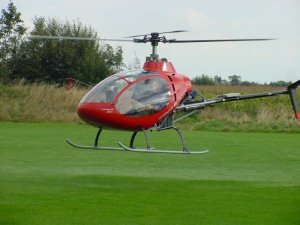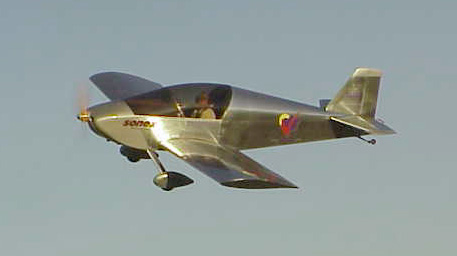|
PROJECT STATUS: December 2004 I have decided to scrap my Mustang-II project in favor of building a Sonex. My rationale for this decision can be read about further down this page or on my Mustang site. Basically I need to be able to see the light at the end of the tunnel, and it's too far away with the Mustang. Building a Sonex from a full kit seems a much more achievable proposition. I am waiting to see Mike Strudwick's full kit which is due to arrive in Tassie in February, to get a better idea of how complete the kit is. The laser-cut and pre-holed skins sound wonderful, but I'm keen to see them first-hand, along with smaller parts, ribs, gussets, miscellaneous brackets etc. and all the other little bits that invariably go into an airplane. I also need to sell my partially completed M-II centre-section kit and get some money together to buy the Sonex kit. In the meantime, as a newcomer to the Sonex scene, I have numerous thoughts and questions floating around in my head, including:
Note: I've moved all these questions (and their
resolutions) to a separate
Newbie Questions page, under the 'thoughts about...' menu. DECEASED MUSTANG PROJECT STATUS: December 2004 Crikey! Another half a year has passed already! What have I been doing?? Well... not building my Mustang, it seems. This has been a year of adventure for me, but not all aviation related. Until recently, aside from the Around New Zealand Air-Race back in Easter, I haven't really been involved with aviation at all. However, I've recently got back into things and have been getting some aerobatic training in a Victa Airtourer. This has been heaps of fun and I'm about 3 hours away from being signed off for aerobatics in my logbook. In fact, it's been so much fun that I don't think I can wait to complete the Mustang. I feel like I need a project that has a faster return on investment, in both time and money, than the M-II. This winter just passed I hiked in to Mt.Rufus (in a world-heritage area) to go snowboarding with my brother. After 6 hours of slogging along in snowshoes I was definitely thinking about alternate ways to get to remote places like this. A helicopter seemed like a very good idea! The more I thought about it, the more I decided that a light helicopter would be an ideal aircraft for getting around Tasmania in. Distances aren't very great here, so the lower cruising speed isn't too much of a problem, and much of the terrain is pretty rough. After some (minor) engine hiccups in the NZ air-race, it occurred to me that I would rather have an engine failure in a helicopter than a fixed wing aircraft, over most of the mountainous terrain over there. And Tassie is in many ways like a scaled-down version of New Zealand. So, I began looking at kit helicopters. This was a lot easier than researching fixed-wing kits, because there are a lot less helicopter kits to choose from! Primary candidates were the Masquito M80, the Rotorway Exec162FA and the Helicycle.
The Masquito M80 sounds fantastic. It is lighter
again than the Exec and thus uses a smaller engine. With the same
So. After learning about the M80, the Exec just didn't do it for me anymore. I would rather wait until the M80 is available, if that ever happens. What to do? Should I persevere with the Mustang? Should I give up entirely on kit aircraft and try to buy a completed airplane? But what? What, what, what, should I do? And then, my brother John mentioned that he might be interested in getting his ultralight license, if it would allow him to fly back to King Island. We weren't sure of the regulations about flying over water in Ultralights, so we took a trip out to the local Ultralight training school at Georgetown. It turns out that flying to King Island is definitely possible, and so John is interested. Hmmmm, thinks I. Perhaps John and I could build an ultralight together. Ultralights are simpler, faster and cheaper to build, and operate, and if I could go halves in the costs, and have two people building... it should all happen a lot more quickly. Then I would have something to fly, and I wouldn't mind taking a lot longer to build the Mustang... my "real" aircraft.
True, it isn't as quick as a Mustang, but it's definitely no slouch. It will cruise at 130-150knots (150-170mph, 240-270kmh) and stalls at 35 knots (!!). That's a speed range of more than 4:1!! And it's stressed to +6/-3g, so is as aerobatic as the M-II. It's a simple design, and is built predominantly with blind rivets. From all accounts the kit seems very builder-friendly, with all skins etc. laser cut to the exact size and shape, with all the holes predrilled. It is built from 6061 alloy which is much more corrosion resistant than the Mustang's 2024 material, and they recommend against using any sort of corrosion proofing at all!! How simple can it get? The average build time for the entire aircraft from the kit is 500-700 hours! Given my impatient personality, as a first-time builder, I'm now thinking I picked the wrong aircraft. I don't think the Sonex is an aircraft to fly around the world in, but it certainly seems like an aircraft that would be good to have fun in, while building an aircraft that IS a potential world-rounder. And the Sonex could certainly fly around Australia. To top things off, I have discovered that there are 3 other people in Tasmania building Sonex's, and one here in my hometown of Launceston! I went and visited him last night, and came away very impressed. So that's where my thinking is at the moment. I'm pretty certain that I'm going to shelve the Mustang for the time being, and start on a Sonex, hopefully in conjunction with my brother. It seems a bit sad to end this site here, but hopefully it will only be a lengthy pause, and I'll get back to the Mustang at some later stage in life. When I do, I will most likely go for as many quickbuild options as I can, so for now, my partially completed Mustang-II Centre-Section kit is FOR SALE. The M-II is a great aircraft, and I'm lucky that my dad owns one so I can still get to fly one occasionally, but building one is just too big a job for me at this point in my life. This is not to say I think the Sonex will be easy, just easi-er! I'm not expecting it to simply slot together, but it is definitely a simpler, cheaper aircraft. Or to see everything (err, or lack of!) that led up to this decision, follow the link below to previous diary entries. My congratulations to, and admiration of, all those Mustang-II builders and pilots out there. Hopefully I'll join you again one day! Thanks also to all those who offered encouragement and advice over the past few years, and those on the Mustang email list. I hope this website will continue to provide some inspiration and insight (and maybe even some useful information?) for potential Mustang builders. Keep building!! Click here for previous diary entries... This link opens a (very large) page on my Mustang-II site in a new window. |

 The Helicycle looks like a great machine (it's even
turbine powered!) and is affordable, but it's only single place.
Besides not being able to carry a passenger, this means I would have
to get my license in a commercial heli such as a Robsinson R22. That
is a very expensive proposition. There is also the "problem" that
the manufacturer won't supply the main rotor bearings until a) you
have a helicopter license, and b) they come and personally check out
your newly built Helicycle, install the bearings and test fly and
rig it for you. I think this is a great safety measure, but it
becomes a problematic when you live on a different land-mass than
the manufacturer.
The Helicycle looks like a great machine (it's even
turbine powered!) and is affordable, but it's only single place.
Besides not being able to carry a passenger, this means I would have
to get my license in a commercial heli such as a Robsinson R22. That
is a very expensive proposition. There is also the "problem" that
the manufacturer won't supply the main rotor bearings until a) you
have a helicopter license, and b) they come and personally check out
your newly built Helicycle, install the bearings and test fly and
rig it for you. I think this is a great safety measure, but it
becomes a problematic when you live on a different land-mass than
the manufacturer. The Rotorway Exec is by far the most popular kit
helicopter on the market, and with good reason. It looks good, has
had years of development and is pretty much the best 2-place light
helicopter available. I was contemplating selling my partially
completed Mustang kit and buying the first stage kit of the Exec.
However after looking at the Masquito M80 the Exec lost a lot of
it's shine, at least for me.
The Rotorway Exec is by far the most popular kit
helicopter on the market, and with good reason. It looks good, has
had years of development and is pretty much the best 2-place light
helicopter available. I was contemplating selling my partially
completed Mustang kit and buying the first stage kit of the Exec.
However after looking at the Masquito M80 the Exec lost a lot of
it's shine, at least for me. capacity fuel tank it has a far greater range, a very similar useful
load and higher performance numbers. I think it also looks a lot
better. This helicopter really had my heart racing. I love it. The
big problem is... it isn't available! I gather Masquito ran into
some financial troubles, and then had a falling out with the
brothers who were actually designing the aircraft, and Masquito went bankrupt. Very
frustrating, since a flying prototype does exist! Along the way Masquito had to design
their own engine for the helicopter. After the demise of Masquito, the engine specialist
who was
capacity fuel tank it has a far greater range, a very similar useful
load and higher performance numbers. I think it also looks a lot
better. This helicopter really had my heart racing. I love it. The
big problem is... it isn't available! I gather Masquito ran into
some financial troubles, and then had a falling out with the
brothers who were actually designing the aircraft, and Masquito went bankrupt. Very
frustrating, since a flying prototype does exist! Along the way Masquito had to design
their own engine for the helicopter. After the demise of Masquito, the engine specialist
who was Then I remembered the
Then I remembered the